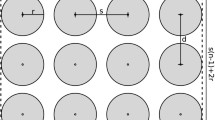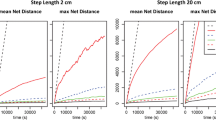Summary
Pheromones have recently been suggested for use in insect pest control. We formulate a discrete version of a model with virgin females (or female equivalent of pheromone) in traps, and explore conditions under which this mechanism can eradicate the pest. Our model is density independent, thus when eradication is not possible, the pest increases without bound, in reality density dependent effects limit population growth. Successive refinements incorporating various features, show that delayed mating together with monogamy has a strong influence on the outcome, whereas other aspects of mating behaviour are relatively unimportant. All our models show that when males are in excess control is impossible but when some virgins are left unmated each day the outcome depends on the parameters. As the birth rate or survivorship increase, control by this method becomes more difficult.
Similar content being viewed by others
References
Barclay, H. andP. van den Driessche (1977) Predator-prey models with added mortality.Can. Ent.109: 763–768.
Barclay, H. andP. van den Driessche (1980) A model for a species with two life history stages and added mortality.Ecol. Modelling11: 157–166.
Beroza, M. andE. F. Knipling (1972) Gypsy moth control with the sex attractant pheromone.Science177: 19–27.
Birch, M., K. Trammel, H. Shorey, L. Gaston, D. Hardee, E. Cameron, C. Sanders, W. Bedard, D. Wood, W. Burkholder andD. Muller-Schwarze (1974) Programs utilizing pheromones in survey or control. 411–462. InM. C. Birch (ed)Pheromones. North Holland, Elsevier.
Borden, J. H. (1974) Aggregation pheromones in the Scolytidae. 135–160. InM. C. Birch (ed)Pheromones. North Holland, Elsevier.
Burnell, D. G. (1977) A dispersal-aggregation model for mountain pine beetle in lodgepole pine stands.Res. Popul. Ecol.19: 99–106.
Fares, Y., P. J. H. Sharpe andC. E. Magnuson (1980) Pheromone dispersion in forests.J. Theor. Biol.84: 335–359.
Fletcher, B. S. (1977) Behavioral responses of Diptera to pheromones, allomones and kairomones. 129–148. InH. H. Shorey andJ. J. McKelvey (eds)Chemical control of insect behavior, Wiley.
Jacobson, M. andM. Beroza (1964) Insect attractants.Scientific American211: 20–27.
Knipling, E. F. andJ. U. McGuire (1966) Population models to test theoretical effects of sex attractants used for insect control.Agric. Info. Bull.308, USDA.
Mertins, J. W., H. C. Coppel andM. G. Karandinos (1975) Potential for suppressingDiprion similis (Hymenoptera: Diprionidae) with pheromone trapping: a population model.Res. Popul. Ecol.17: 77–84.
Minks, A. K. (1977) Trapping with behavior modifying chemicals: feasibility and limitations. 385–394. InH. H. Shorey andJ. J. McKelvey (eds)Chemical control of insect behavior. Wiley.
Roelofs, W. L., E. H. Glass, J. Tette andA. Comeau (1970). Sex pheromone trapping for redbanded leaf roller control: theoretical and actual.J. Econ. Ent.63: 1162–1167.
Shorey, H. H. (1973) Behavioral responses to insect pheromones.Ann. Rev. Entomol.18: 349–380.
Shorey, H. H. andL. K. Gaston (1967) Pheromones. 241–265. InW. W. Kilgore andR. L. Doutt (eds)Pest control-biological, physical, and selected chemical methods. Academic Press.
Silverstein, R. M. (1981) Pheromones: background and potential for use in insect pest control.Science213: 1326–1332.
Author information
Authors and Affiliations
Rights and permissions
About this article
Cite this article
Barclay, H., van den Driessche, P. Pheromone trapping models for insect pest control. Res Popul Ecol 25, 105–115 (1983). https://doi.org/10.1007/BF02528786
Issue Date:
DOI: https://doi.org/10.1007/BF02528786




